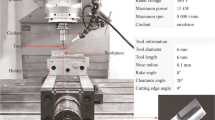Abstract
Castamide is vulnerable to humidity up to 7%; therefore, it is important to know the effect of processing parameters on Castamide with and without humidity during machining. In this study, obtained quality of surface roughness of Castamide block samples prepared in wet and dry conditions, which is processed by using the same cutting parameters, were compared. Moreover, an artificial neural network (ANN) modeling technique was developed with the results obtained from the experiments. For the training of ANN model, material type, cutting speed, cutting rate, and depth of cutting parameters were used. In this way, average surface roughness values could be estimated without performing actual application for those values. Various experimental results for different material types with cutting parameters were evaluated by different ANN training algorithms. So, it aims to define the average surface roughness with minimum error by using the best reliable ANN training algorithm. Parameters as cutting speed (V c), feed rate (f), diameter of cutting equipment, and depth of cut (a p) have been used as the input layers; average surface roughness has been also used as output layer. For testing data, root mean squared error, the fraction of variance (R 2), and mean absolute percentage error were found to be 0.0681%, 0.9999%, and 0.1563%, respectively. With these results, we believe that the ANN can be used for prediction of average surface roughness.
Similar content being viewed by others
References
Davim JP, Silva LR, Festas A, Abrão AM (2009) Machinability study on precision turning of PA66 polyamide with and without glass fiber reinforcing. Mater Des 30:228–234
Adams N (1963) Friction and deformation of nylons. J Appl Polym Sci 7:2075–2103
Samyna P, Baets P, Schoukens G, Van Driessche I (2007) Friction, wear and transfer of pure and internally lubricated cast polyamides at various testing scales. Wear 262:1433–1449
Palabiyik M, Bahadur S (2000) Mechanical and tribological properties of polyamide 6 and high density polyethylene polyblends with and without compatibilizer. Wear 246:149–158
Samyn P, Tuzolana TM (2007) Effect of test scale on the friction properties of pure and internal-lubricated cast polyamides at running-in. Polym Test 26:660–675
Liu CZ, Wu JQ, Li JQ, Ren LQ, Tong J, Arnell RD (2006) Tribologicalbehaviours of PA/UHMWPE blend under dry and lubricated condition. Wear 260:109–115
Mata F, Reis P, Davim JP (2006) Physical cutting model of polyamide composites (PA66 GF30). Mater Sci Forum 514–516:643–647
Wang W, Kweon SH, Yang SH (2005) A study on roughness of the micro-end-milled surface produced by a miniatured machine tool. Int J Adv Manuf Technol 162–13:702–708
Ozcelik B, Bayramoglu M (2006) The statistical modeling of surface roughness in high-speed flat end milling. Int J Mach Tools Manuf 46:1395–1402
Franco P, Estrems M, Fuara F (2004) Influence of radial and axial run outs on surface roughness in face milling with round insert cutting tools. Int J Mach Tools Manuf 44:1555–1565
Benardos PG, Vosniakos GC (2003) Predicting surface roughness in machining: a review. Int J Mach Tools Manuf 43:833–844
Brezocnik M, Kovacic M (2003) Integrated genetic programming and genetic algorithm approach to predict surface roughness. Mater Manuf Process 18(3):475–491
Pal SK, Chakraborty D (2005) Surface roughness prediction in turning using artificial neural network. Neural Comput Appl 14:319–324
Ozel T, Karpat Y (2005) Predictive modeling of surface roughness and tool wear in hard turning using regression and neural networks. Int J Mach Tools Manuf 45:467–479
Durmus HK, Ozkaya E, Meric C (2006) The use of neural networks for the prediction of wear loss and surface roughness of AA6351 aluminium alloy. Mater Des 27:156–159
Yalcın B, Ozgur AE, Koru M (2009) The effects of various cooling strategies on surface roughness and tool wear during soft materials milling. Mater Des 30:896–899
Colak O, Kurbanoglu C, Kayacan MC (2007) Milling surface roughness prediction using evolutionary programming methods. Mater and Des 28:657–666
Topal EY (2009) The role of step over ratio in prediction of surface roughness in flat end milling. Int J Mech Sci 51:782–789
Zain AM, Haron H, Sharif S (2010) Prediction of surface roughness in the end milling machining using artificial neural network. Expert Syst Appl 37:1755–1768
Abeesh BC, Dabade UA, Joshi SS, Bhanuprasad VV, Gadre VM (2008) Modeling of surface roughness in precision machining of metal matrix composites using ANN. J Mater Process Technol 197:439–444
Yang JL, Chen JC (2001) A systematic approach for identifying optimum surface roughness performance in end-milling operation. J Ind Technol 45:110–120
Tosun N, Özler L (2002) A study of tool life in hot machining using artificial neural networks and regression analysis method. J Mater Process Technol 124:99–104
Çaydaş U, Hasçalık A (2008) A study on surface roughness in abrasive waterjet machining process using artificial neural networks and regression analysis method. J Mater Process Technol 202(1–3):574–582
Kalogirou SA, Panteliou S, Dentsoras A (1999) Modeling of solar domestic water heating systems using artificial neural networks. Sol Energy 65(3):35–42
Kalogirou SA, Neocleous CS, Schizas CN (1988) Artificial neural networks for modeling the starting-up of a solar, steam-generator. Appl Energy 60:89–100
Chouai A, Laugier S, Richon D (2002) Modeling of thermodynamic properties using neural networks: application to refrigerants. Fluid Phase Equil 199(1–2):53–62
Kalogirou SA (1999) Application of artificial neural networks in energy systems: a review. Energy Convers Manage 40:1073–1087
Bozdemir M, Gölcü M (2008) Artificial neural network analysis of springback in V bending. J Appl Sci 8(17):3038–3043
Bozdemir M (2010) The analysis of humidity factor in Castamide materials on surface roughness with the help of artificial neural network. Sci Res Essays 5(11):1370–1375
Bechtler H, Browne MW, Bansal PK, Kecman V (2001) New approach to dynamic modeling of vapour-compression liquid chillers: artificial neural networks. App Energy 21:941–953
Matlab Version 6.5 Online Manual
Author information
Authors and Affiliations
Corresponding author
Rights and permissions
About this article
Cite this article
Bozdemir, M., Aykut, Ş. Optimization of surface roughness in end milling Castamide. Int J Adv Manuf Technol 62, 495–503 (2012). https://doi.org/10.1007/s00170-011-3840-2
Received:
Accepted:
Published:
Issue Date:
DOI: https://doi.org/10.1007/s00170-011-3840-2



